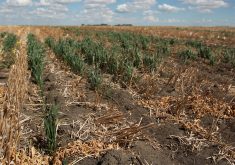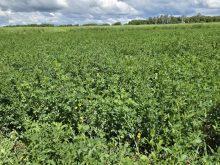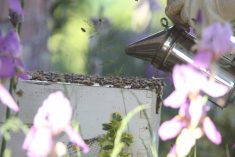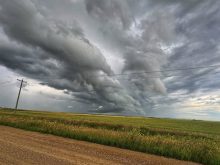Mental images from the drought of 2021, such as seeding into dust, scorched crops and dugouts with only a puddle of water at the bottom, are still etched into the memories of most farmers in Manitoba.
That’s likely why some producers are sounding positive about a spring snowstorm that dumped 40 to 80 centimetres of snow on southern Manitoba last week.
“I’m not too worried,” said Andrew Ayre, who runs Southern Seed in Minto, Man., south of Brandon. “Fortunately, our land in this area it’s pretty much like a giant sponge. It was so dry in 2021, I think a lot of this moisture will be sucked up (by the soil). I’m thankful for the snow…. I think we will be more than thankful for the benefits of the snow, when it melts.”
Read Also

Agri-business and farms front and centre for Alberta’s Open Farm Days
Open Farm Days continues to enjoy success in its 14th year running, as Alberta farms and agri-businesses were showcased to increase awareness on how food gets to the dinner plate.
From April 13-15, a Colorado Low weather system delivered a massive amount of snow and rain to North Dakota, southern Manitoba and eastern Saskatchewan, closing schools and roads across much of the region.
An additional 10 cm of snow fell April 17 and Ayre was clearing snow from his yard the following morning. His cropland could remain wet well into next month, but Ayre is focusing on the positive.
“Yes, we’ll be later sowing (a crop). But if we sow in the middle of May into warming conditions, with moisture, that’s far better than sowing on the last day of April with dust. And then having the wind blow for two weeks.”
Rauri Qually, who farms west of Winnipeg, near Dacotah, said it could take a month for his land to dry out. If he does get on the land by May 20, it would be a dramatic change from last year.
By the third week of April last year, Qually had already seeded his cereal crops because much of the snow had melted by late March.
“As I recall, I had some (soybeans) custom planted. I think they went in the first week of May.”
The Manitoba Agriculture Crop Report from last year says about 20 percent of the provincial crop was in the ground by the first week of May. That will not happen this year. It’s possible that zero acres will be seeded by the first week of May.
However, assuming seasonal weather returns to the eastern Prairies in late April and early May, the snow should melt quickly.
Around Winnipeg and in the Red River Valley it will take a while for the soil to dry up because water was ponding on farm fields before the spring blizzard.
Most crops could be planted after the May long weekend. But, for now, Qually is sticking with his seeding plan and crop rotation.
“Being of Norwegian descent, I’m pretty darn stubborn,” he said with a laugh. “We just need some warmer weather and lots of sunshine. And even some rain, to get the frost out of the ground.”
Further west, near Pipestone, Man., Melissa Atchison is also feeling positive about the snowfall.
Last spring, Atchison was facing a water shortage on her cattle ranch. She had to hire a backhoe operator to deepen and expand dugouts on her pastures. The story was similar in much of southern Manitoba and into Saskatchewan, as many dugouts were half-full of water and pasture growth was almost non-existent.
“(I’m) very happy with this wet snow that’s going to seemingly have a nice slow melt, to give it an opportunity to soak in,” Atchison said. “This snow will certainly recharge the aquifer and get those dugouts filled up.”
For livestock producers, the wintery spring weather hasn’t been all positive. The snow and wet conditions have made calving more challenging. And some farmers are running low on feed.
“We’re having quite the delayed spring and feed supplies are tight for a lot of folks,” said Atchison, who is vice-president of the Manitoba Beef Producers. “So, we’re hoping spring shows up fairly soon.”
Around Minto and other parts of southwestern Manitoba, it’s possible that low spots on cropland will remain too wet for seeding this spring.
That isn’t ideal, especially when crop prices are at record levels and growers are hoping to plant a crop on every possible acre of land.
But after a growing season like 2021, with no rain, 35 C weather, absurdly dry soils and crop yields that were half of normal or worse, losing some acres to excess moisture would be a welcome change.
















